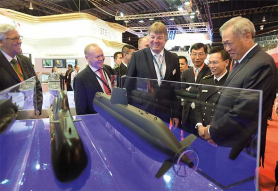MAKING REGIONAL SEAS SAFER
STORY // Koh Eng Beng
PHOTO // PIONEER Photographers
Asian-Pacific navy chiefs discuss ways to tackle territorial disputes, terrorism and piracy at the region's largest maritime defence show.
Dr Ng (far right) viewing replicas of the Type 218SG submarines, the latest additions to the RSN's submarine fleet. They were unveiled for the first time at IMDEX Asia.
Territorial disputes in the South China Sea could potentially escalate into a full blown conflict, causing shipping and trade to come to a standstill and affecting the livelihood of millions.
To find ways to resolve this and other maritime security challenges, the Republic of Singapore Navy (RSN) brought together 50 delegations from 40 countries at the 10th International Maritime Defence Exhibition and Conference (IMDEX) Asia from 19 to 21 May.
Addressing an audience that included navy chiefs and vice chiefs, coast guard heads, maritime defence professionals and academics, Minister for Defence Dr Ng Eng Hen said that China and ASEAN countries should expeditiously conclude a code of conduct to resolve disputes without resorting to the use of force.
"Any disruption to maritime trade routes in this part of the world will affect not only Singapore but also the global economy. All countries therefore share a collective interest to keep our regional sea lines of communication open and secure."
He added that the region faced threats such as terrorism and piracy. Al-Qaeda, for instance, had recently called for attacks targeting tankers in the Strait of Malacca, and piracy attacks in Asia had gone up by 22 percent last year.
Countries should step up dialogue and practical co-operations to tackle these challenges, said Dr Ng. To this end, the biennial IMDEX Asia was a good discussion platform to strengthen maritime security cooperation. It comprised an exhibition and three conferences.
Chief of Defence Force Lieutenant-General Ng Chee Meng (third from left) interacting with foreign participants of MARISX, an exercise which aims to strengthen information-sharing linkages among various navies.
Enhancing submarine operational safety
At the 4th International Maritime Security Conference (IMSC), where discussions centred on addressing security challenges through collaboration, Minister of State for Defence Dr Mohamad Maliki Bin Osman noted that one possible area for cooperation was in submarine operational safety.
Pointing out that more navies will operate more submarines in the increasingly congested South China Sea, Dr Maliki said: "While this raises safety issues, there are also opportunities for cooperation."
He cited the Asia-Pacific Submarine Conference (APSC) - co-hosted by the RSN and the United States Navy (USN) for discussions on submarine rescue and operational safety - as an example. Held in conjunction with IMDEX Asia for the first time, the APSC also saw the RSN inking a bilateral agreement with the USN on submarine rescue.
Chief of Navy Rear Admiral (RADM) Lai Chung Han, who spoke at the IMSC, also called for countries to come up with a regional framework for submarine operational safety.
For a start, RADM Lai said, navies could share non-sensitive information - such as the movement of large crude carriers as well as dredging and other underwater activities - through the Singapore-based Information Fusion Centre. They could also share best practices in submarine rescue, and work towards creating a code of conduct to guide submariners on manoeuvring to prevent accidents during an unlikely encounter.
RADM Lai also proposed extending coordinated piracy patrols to new hotspots, the Philip Channel and east of Johor. Such patrols have been successful in bringing down the number of piracy attacks in the Malacca Strait in recent years.
Dr Maliki (seated) on board the Royal Australian Navy's frigate HMAS Perth, one of the 20 warships on display at IMDEX Asia.
Joint training drills
Another way to bolster cooperation was through the joint training drills hosted by the RSN on the sidelines of IMDEX Asia, said Dr Maliki. The region's first code of conduct for unplanned encounters between navy ships and aircraft was used for the first time in this series of war games.
The war games, codenamed Maritime Information Sharing Exercise (MARISX), and the Western Pacific Naval Symposium Multilateral Sea Exercise (WMSX), were held on shore and at sea.
On shore, navies, coast guards and maritime agencies from about 30 countries tested their information-sharing linkages, while at sea, eight navies carried out drills that included the seizing of terrorist vessels.
Singapore is the only country in South-east Asia with full-fledged submarine rescue capabilities like the MV Swift Rescue and DSAR-6 submersible.
Engineering exchange
At IMDEX Asia 2015, 180 defence contractors from 28 countries showcased their hardware. As part of the exhibition, 20 warships from 12 countries were on display at Changi Naval Base. These included the RSN's Landing Ship Tank (LST) RSS Endeavour, Frigate RSS Intrepid, and rescue vessel MV Swift Rescue (See Pg 6).
About 200 naval engineering professionals from 20 countries also gathered at the 2nd International Naval Engineering Conference (INEC) @ IMDEX 2015 to discuss new developments in naval technology.
Keynote speaker Permanent Secretary (Defence Development) Major-General (MG) (NS) Ng Chee Khern highlighted how the Singapore Armed Forces (SAF) had tapped on technology to build hardware that could be rapidly reconfigured for different missions.
An example is the RSN's Endurance-class LSTs that can transport equipment and personnel via cranes, fast craft or helicopter. Such versatility has proven useful in missions like the Humanitarian and Disaster Relief Assistance operation for the Boxing Day tsunami in 2006.
MG (NS) Ng said the SAF needed to build versatile capabilities for future missions that it may not be able to envisage today. "This is because we do not always know the sort of operational scenarios in which the SAF would be called into action."










